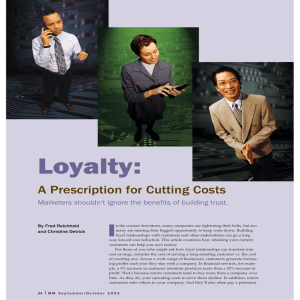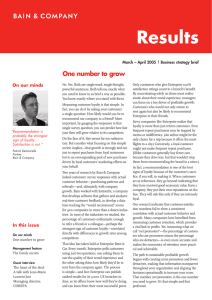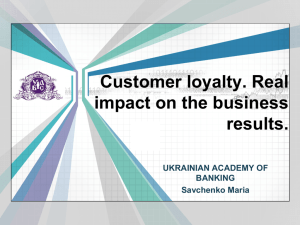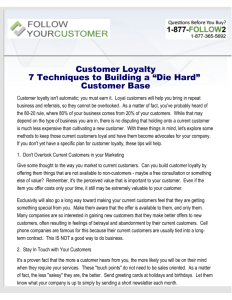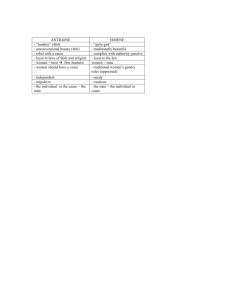Prescription for cutting costs
advertisement
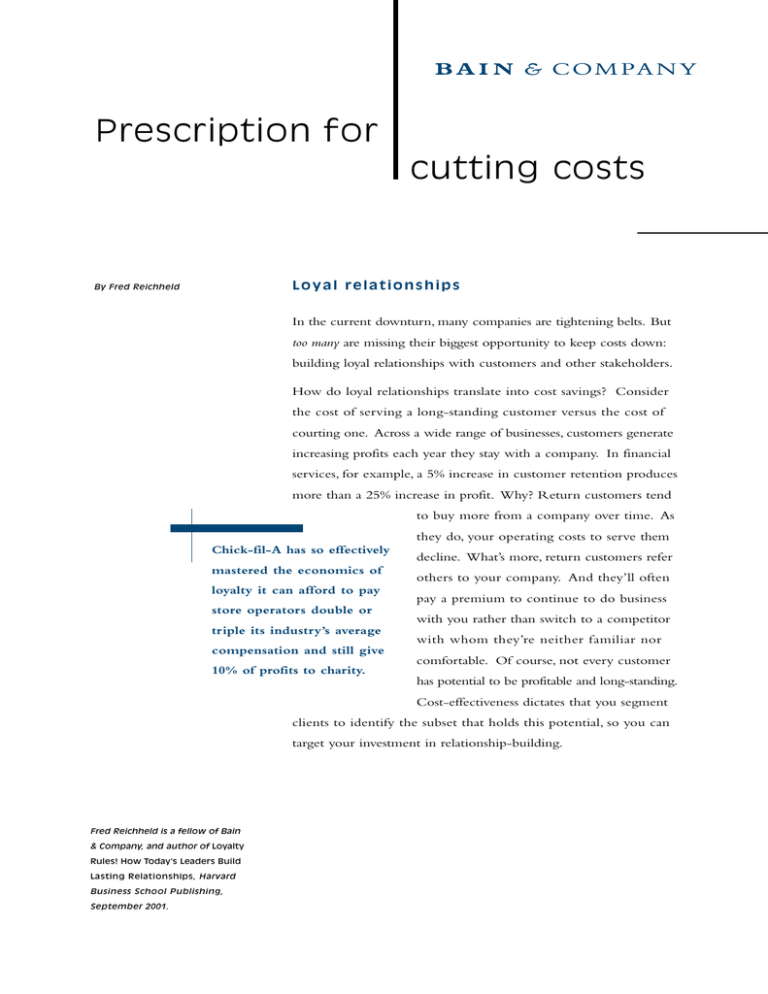
Prescription for cutting costs Loyal relationships By Fred Reichheld In the current downturn, many companies are tightening belts. But too many are missing their biggest opportunity to keep costs down: building loyal relationships with customers and other stakeholders. How do loyal relationships translate into cost savings? Consider the cost of serving a long-standing customer versus the cost of courting one. Across a wide range of businesses, customers generate increasing profits each year they stay with a company. In financial services, for example, a 5% increase in customer retention produces more than a 25% increase in profit. Why? Return customers tend to buy more from a company over time. As they do, your operating costs to serve them Chick-fil-A has so effectively mastered the economics of loyalty it can afford to pay store operators double or triple its industry’s average compensation and still give 10% of profits to charity. decline. What’s more, return customers refer others to your company. And they’ll often pay a premium to continue to do business with you rather than switch to a competitor with whom they’re neither familiar nor comfortable. Of course, not every customer has potential to be profitable and long-standing. Cost-effectiveness dictates that you segment clients to identify the subset that holds this potential, so you can target your investment in relationship-building. Fred Reichheld is a fellow of Bain & Company, and author of Loyalty Rules! How Today’s Leaders Build Lasting Relationships, Harvard Business School Publishing, September 2001. Consider the case of Vanguard, the mutual fund industry cost leader. When Jack Brennan took over Loyalty leaders develop annual report cards as CEO in 1996,Vanguard’s flagship S&P 500 Index on suppliers and dealers with as much care Fund costs were just 0.20% of assets. By 1999, they as they give to annual reports for investors. had declined to 0.18%—a 10% improvement. One of the reasons is that Brennan, like his predecessor, measures including sales, sales growth, and profits. John Bogle, is committed to customer retention. The stores whose performance falls into the bottom And Brennan’s particular passion is selecting the 15-20% of all Chick-fil-A units automatically get right kinds of customers up front—the kinds with extra attention from company consultants. Customer high potential for long-term relationships with the survey frequency is doubled, and improvement plans firm. For example, a few years back,Vanguard are developed with each operator. Operators and rejected an institutional investor that tried to invest employees receiving the added scrutiny understand it $40 million in a fund, because Vanguard suspected is meant to help them get back on track; they know that the customer would soon churn the investment, that long-term relationships require honest, two- creating extra costs for all the existing customers. way communications and learning, and they value The customer complained to Brennan, who supported the company’s commitment to that goal. The the decision and used it as an opportunity to ultimate result, of course, is a dramatic saving in underscore the need to be selective about customers. hiring costs; Chick-fil-A’s average store operator Loyalty leaders also reduce costs by building trusting turnover rate is 5% versus the competition’s 35-40%. relationships with employees. Consider Chick-fil-A, Customers, employees, suppliers, distributors, a chain of quick-service restaurants that has so channel partners—almost every stakeholder in your effectively mastered the economics of employee company is a potential cost-reduction crusader. loyalty that it can afford to let store operators earn If you facilitate a supplier’s operations by being compensation that’s double or triple industry averages, flexible about delivery times, for example, that while generating enough cash to grow the chain supplier might be more willing to flex for your and give about 10% of profits to charity. Those special need. And over time, as you build trust, that compensation standards help grow loyal employees supplier will likely be loyal to you even if one of who nurture attractive client relationships. your competitors offers a more attractive short-term Performance feedback, too, bolsters loyalty. Every contract. You’ll both save on switching costs; and store operator can easily find out (right on the in- if you’re attentive, you’ll maximize the efficiency store computer) his or her standing in comparison of your transactions as your relationship matures. to the other 600 or so Chick-fil-A operators on B a i n & C o m p a n y, I n c . Prescription for cutting costs: Loyal relationships 2 Identify ways to help underperformers: What are the secrets of the loyalty leaders? Develop annual relationship report cards on The companies that best understand cost savings suppliers and dealers (and customers and employees) through loyalty take very deliberate steps. A few with as much care as you give to annual reports you might consider: for investors. Test a 360-degree feedback system, Modify customer-a acquisition incentives: starting with senior managers and rolling out to Reward your sales teams and marketing channels all employees. for acquiring customers that stick. Consider Use the Internet: commission or bonus reductions if customers Loyalty leaders such as Vanguard have shifted defect before 18 months. almost half of their customer transactions to the Reallocate marketing investments: Web. Make sure your Web site is so simple to Systematically rank all of your customer use that many customers will prefer this faster acquisition campaigns on the basis of their and cheaper alternative. yield of loyal customers. Shift resources towards No company is immune to the pressures of the programs that attract the richest mix of loyal market. But companies that focus on building customers. (Many firms today are wasting half loyal relationships that by their very nature keep costs their marketing expenses on disloyal customers to a minimum are far better positioned to remain who will never stick around long enough to strong in the face of market turbulence. pay back the acquisition investment.) BAIN & COMPANY, INC. Corporate Headquarters Two Copley Place Boston, Massachusetts 02116 1 (617) 572 2000 Amsterdam Milan • • Atlanta Munich • • Beijing New York • • Boston Paris • • Brussels Rome • • Chicago San Francisco • • Dallas • São Paulo Hong Kong • Seoul • • Johannesburg Singapore • • London Stockholm • • Los Angeles Sydney • Tokyo • • Madrid Toronto Mexico City • • Zurich
